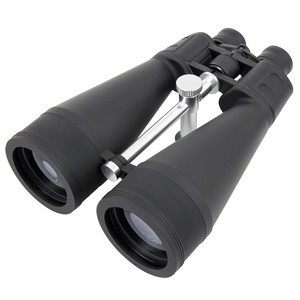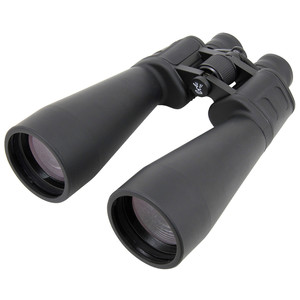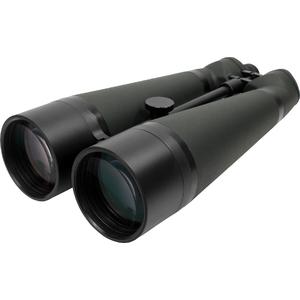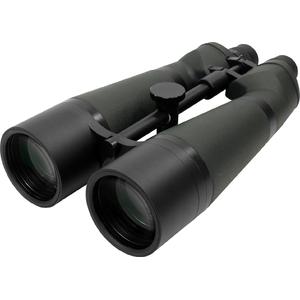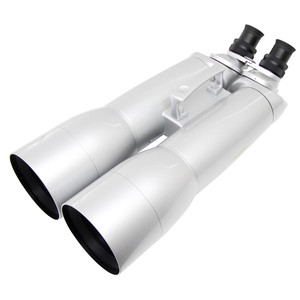Astronomy with binoculars: the 10 most beautiful objects in the spring night sky
Why not leave your telescope at home tonight? These 10 objects will make an impression through any binoculars.

Binoculars are often overlooked as an astronomical instrument. But they can offer some wonderful alternative observation experiences.
The advantage of binoculars for observing
Unlike a telescope, binoculars are small enough to fit in any luggage. This is an advantage - especially when you travel. You may not always feel like filling the entire boot of your car with astronomical equipment. Perhaps the skies have suddenly cleared and you plan to observe a little before the weather closes in again and clouds obscure the view. In this case, binoculars are a real alternative.
What can I observe with binoculars?
Planetary details are not visible with binoculars, the image is far too small. But open clusters, nebulae, and even some galaxies are wonderful to see. Besides: roaming across the Milky Way on a warm summer night is one of the most wonderful activities you can imagine.
It doesn't matter which kind of binoculars you use. Even a 10×50 or 12×50 pair offers great experiences. Large binoculars with 70-100mm aperture collect even more light. 70mm binoculars gathers almost twice as much light as those with a 50mm aperture. Binoculars with a large aperture and high magnification also has another advantage: their resolution capability. This is, for example, a benefit when observing binary stars.
What objects can you observe in the spring and summer skies?
I've gathered together some hot tips for you:
The most beautiful objects for a night out with your binoculars
If we now look to the sky in the evening hours, we can see the winter constellations slowly bid farewell. The constellation of Orion can be seen in the southwest and sets in the west around midnight. However from the east Leo, the herald of spring, is already on its way. Still close to the horizon, the constellation of Boötes with its bright star Arcturus peers over the landscape.
Let's take a night time stroll to the most beautiful objects to observe with our binoculars.
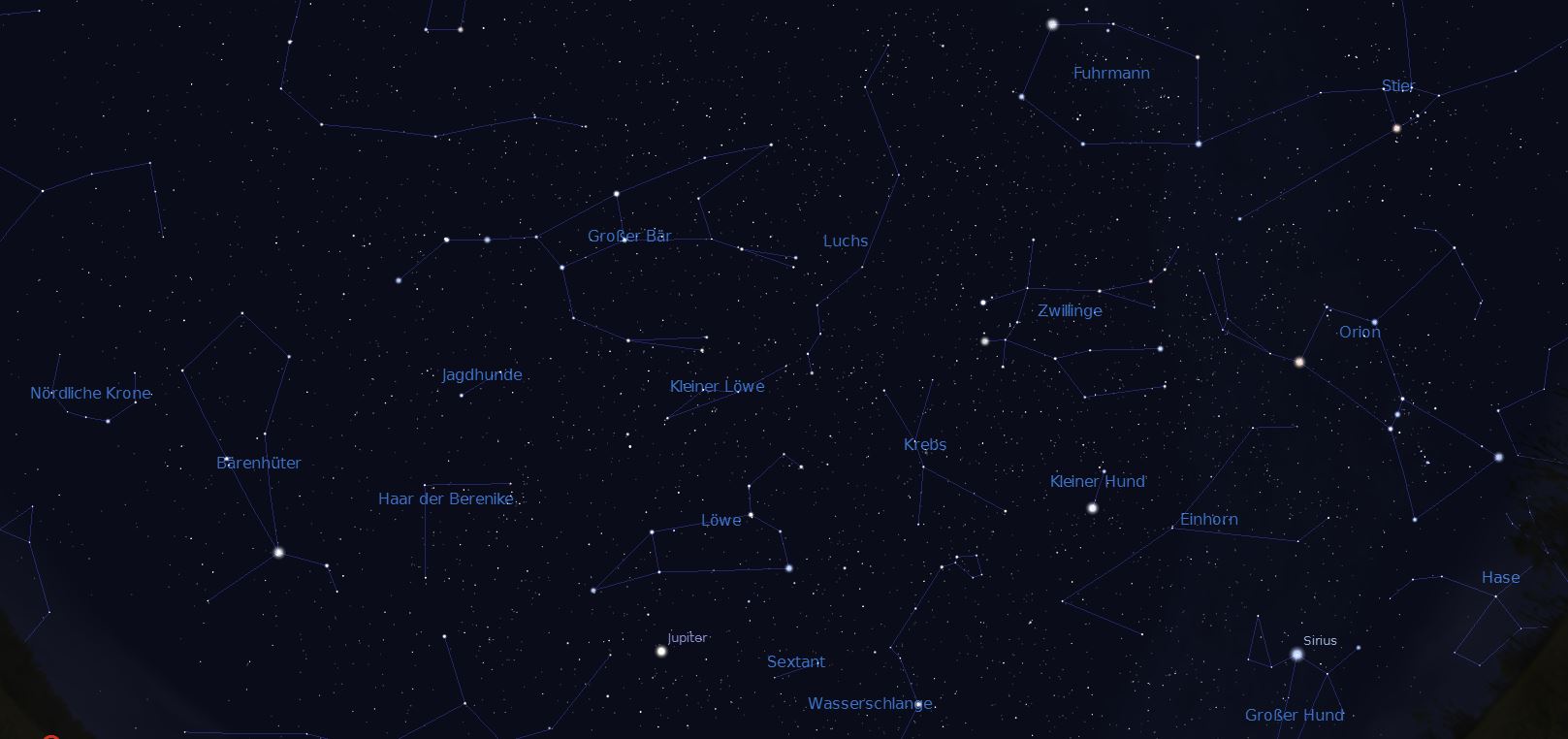
1. M45 Pleiades
People who are not familiar with the night sky often confuse the Pleiades with Ursa Minor. Indeed, with the naked eye, their patterns of stars do appear quite similar. I have often encountered this misunderstanding during presentations at public observatories.
The Pleiades are among the few clusters that are visible with the naked eye. To be precise, 7 stars are visible, which were even found to have be depicted on the 4000-year-old Nebra Sky Disc. Observations of this cluster therefore go back to the early Bronze Age.
The Pleiades are a magnificent cluster for binoculars with, for example, 10x magnification. Even in small 34mm or 42mm binoculars you can see dozens of glittering stars, framed by the delicate blue of the bright primary stars. If you want to inspire someone with astronomy, let them observe the Pleiades with a pair of binoculars. There is hardly any other object that offers such a “wow” effect.
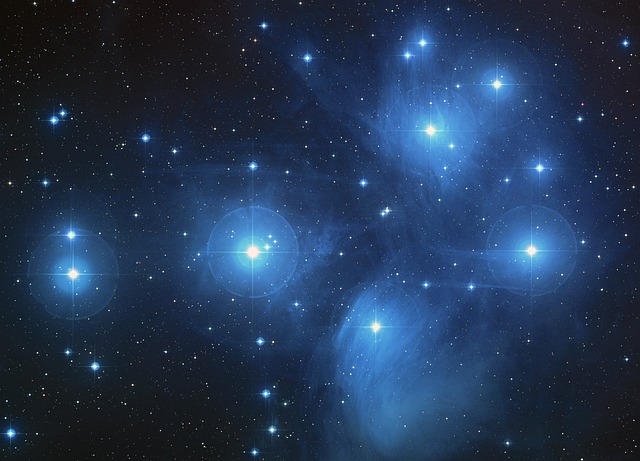 The Pleiades can be seen even with small binoculars, but the reflection nebula can only be seen in photographs.
The Pleiades can be seen even with small binoculars, but the reflection nebula can only be seen in photographs.2. Open cluster M35
This open cluster is the most famous object in the constellation of Gemini. It is about 3,000 light years away and is 24 light years across. On dark nights, we can see the magnitude 5.1 object as a diffuse hazy speck.
To find it with binoculars it is best to start from the magnitude 3.3 star η and head in a northwest direction. Once the star η is no longer central in your field of view, you should already be able to make out M35 at the edge. With binoculars we see 20-50 stars, which no longer appear a hazy speck, but resolved and beautiful.
 The constellation of Gemini with the open cluster M35
The constellation of Gemini with the open cluster M353. Open cluster M44
The M44 star cluster is around 610 light years away, bears the beautiful sounding name Praesepe which is Latin for “manger”, and is also known as the Beehive Cluster. It is in fact the second-brightest star cluster after the Pleiades, and is closest to Earth. From dark locations you can see Praesepe with the naked eye, but it is only with binoculars that the cluster resolves into individual stars., Galileo Galilei counted 40 stars with his small telescope as far back as 1609.
With your binoculars you can see much more detail: from 10x50 binoculars upwards, you will make out more than 45 stars. The cluster looks even more beautiful than when observed with a telescope. How do you find the cluster? It is in the middle of the constellation Cancer, between the northern and southern donkey. These two magnitude 4.7 and 3.9 stars form a triangle with M44.
Scientists assume that the cluster, which is about 700 million years old and 17 light-years across, was formed together with the well-known Hyades cluster. Fun fact: in the past, the cluster was considered to be an indication of bad weather, because if the Beehive could no longer be seen with the naked eye, it was said that bad weather was on its way.
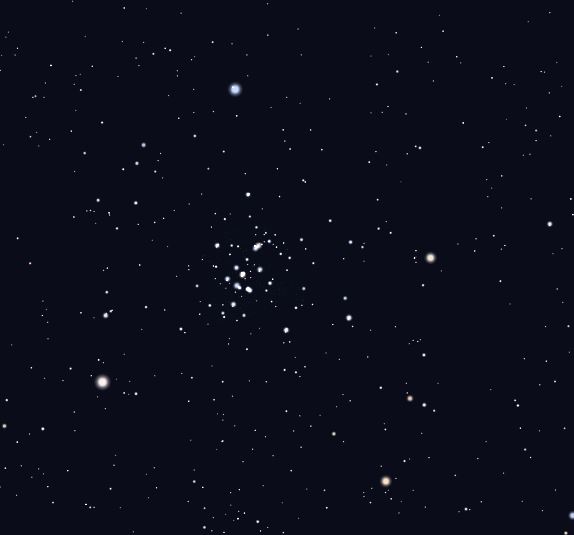 Doesn’t a celestial manger or beehive sound much more lyrical than M44?
Doesn’t a celestial manger or beehive sound much more lyrical than M44?4. Binary star Alcor
The best-known binary star in the night sky can be found in the constellation Ursa Major. Point your binoculars at the middle tiller star and it will reveal another star called Alcor, which is easily resolved.
It is also known in some languages as the Little Rider because it seems to be riding on the bright primary star Mizar. You can try to pick it out without binoculars if your eyes are sharp enough.
This binary star is quite famous as an eyesight test, because the distance between the two stars is just 12 arc minutes. So you can be proud if you can resolve them, because it means that you have excellent eyesight.
Alkor and Mizar form an optical binary star, for which even a very small pair of binoculars is sufficient. Although the stars appear to be a binary star, they are probably not connected to one another. With 20x80 binoculars you will discover a surprise: Mizar itself is a binary star system. If you use a tripod, you will be able to separate the second component.
5. Galaxy pair M81/82
Spring is usually classic galaxy season, but there is a duo that is visible all year round: the two interacting galaxies M81 and M82. And what makes these special is that they are accessible with binoculars. They are not difficult to find with a binocular field of view of 6° to 7°, however this pair of galaxies lies in a region far from any bright stars.
It is best to locate them by starting from two stars in the Big Dipper’s bowl: Phecda and Dubhe. Phecda is the lower left star of the bowl and Dubhe is the upper right one. If you take an imaginary line from Phecda to Dubhe and beyond, you will encounter M81 and M82 after around 2 fields of view through your binoculars.
M82 is the more noticeable of the two and, with a brightness of magnitude 8.6, you should see it immediately with your binoculars. It is also known as the Cigar Galaxy because its shape appears a little thicker in the middle and tapered at the ends - just like a cigar. It seems that M81 is responsible for its appearance, both galaxies collided around 500 million years ago.
By the way: M81 and M82 are around 100,000 light years distance from one another. From purely a size point of view, our Milky Way would fill the space between its two colleagues exactly.
 Two beautiful objects: Alcor, the middle star of the handle, and the galaxy pair M81/M82
Two beautiful objects: Alcor, the middle star of the handle, and the galaxy pair M81/M826. In Leo: Regulus
You probably already know the primary star of the constellation Leo. But did you also know that it is a binary star? You can observe it with your binoculars.
Regulus, a blue-white star with a surface temperature of 12,000 Kelvin, is around 3.5 times larger than the Sun. The ball of gas, which is 77 light years away, rotates around its own axis in just 15 hours, which causes it to be highly oblate. At a distance of 175″ we find a magnitude 8 bright orange companion that can be seen ,for example, with 10x50 binoculars.
 Regulus is one of the least-noticed binary stars
Regulus is one of the least-noticed binary stars7. Open cluster M48
Our largest constellation is Hydra, which winds itself across a 75° section of the spring night sky. One of its most interesting objects for binoculars is the open cluster M48, which borders the constellation Monoceros.
The cluster is a wonderful object for normal or large binoculars because, at a typically small magnification between 8 and 20 times, it looks more beautiful than through a telescope.
The 300-million-year-old cluster comprises around 80 stars and is 2,500 light-years away. You notice a central collection of really bright stars and a more extensive outer section, which you will only be able to see under a dark sky.
Here is how to find M48: locate the triangle between Hydra’s head, Monoceros’ tail base, and the constellation Canis Minor.
If you extend an imaginary line between the two stars in Canis Minor to the left, you will encounter the magnitude 4.3 star 29 Mon. Centre your binoculars on this star, then move your field of view around 3° to the southeast. Since binoculars generally have a field of view of around 5°, the cluster should automatically appear in your field of view.
Alternatively, you can also find it by starting at the star C Hya which, at magnitude 3.9, is actually slightly brighter than 29 Mon. Centre your binoculars as before, but now move your field of view 3° southwest until you can clearly make out M48.
 The open cluster M48, Stellarium
The open cluster M48, Stellarium8. Globular cluster M3
Almost halfway between Arcturus, the brightest star in Boötes, and Cor Caroli in Canes Venatici, you will find the globular cluster M3. Just think of a line connecting the two stars, move to its centre, and you have the object.
Globular clusters are naturally compact and distant objects. With binoculars, they appear only as diffuse and unresolved spheres. But this doesn’t make them any less interesting. I believe that the science behind the object alone makes observing M3 really exciting. M3 has about 500,000 stars, is 30,000 light years away and has a diameter of 125 light years. There are nearly 200 variable stars within M3. This is a record because until now, no globular cluster has been found to have more variable stars.
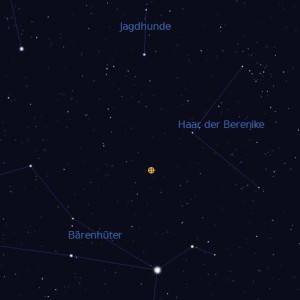 The herald of spring: globular cluster M3
The herald of spring: globular cluster M39. Open cluster Mel 111
The open cluster Melotte 111 in the constellation Coma Berenices has been observed since ancient times. Mythology tells us that the gods decreed that Queen Berenices’ golden locks were to be placed in the sky.
With the naked eye you can see about 12 stars, in small binoculars (e.g. 7×50 binoculars) you will discover at least 35 stars. The magnification must not be too high, otherwise the cluster character will be lost. You will find the cluster just below the magnitude 4.3 star γ Com.
Some more data: the cluster is around 290 light years away and is 500 million years old. Mel 111 has been classified as a moving group because all the members move together in one direction.
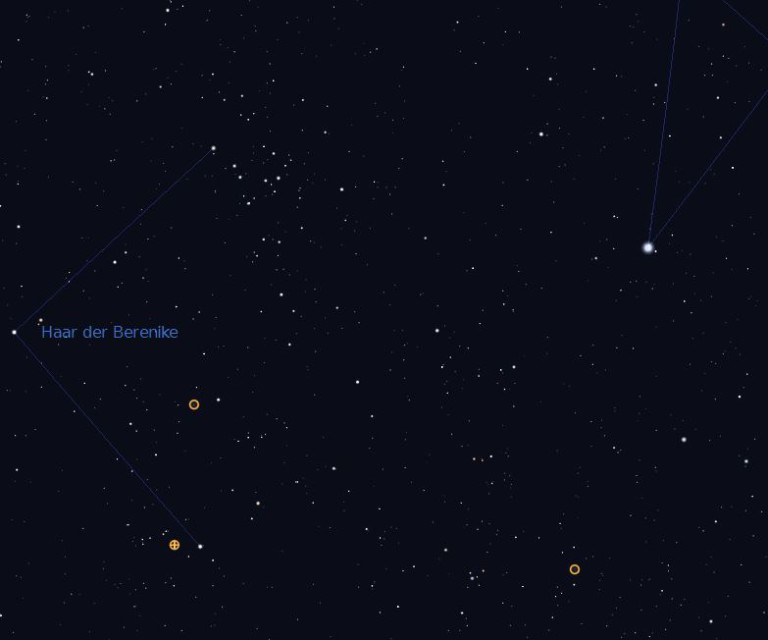 Melotte 111: binoculars with 7 to 8x magnification will give you the most beautiful impression.
Melotte 111: binoculars with 7 to 8x magnification will give you the most beautiful impression.10. The challenge: galaxy M98
The constellations Virgo and Coma Berenices are particularly interesting in spring. In this region we find countless galaxies, as we look into the realm of the huge Virgo cluster of galaxies, which is a neighbour of the local group. This region is both a test and a challenge for binoculars. Now you have to try to squeeze every last bit of performance out of your instrument.
A dark location on a night with good seeing is a matter of course for observing galaxies. Take, for example, the galaxy M98 in the constellation Coma Berenices. It has a brightness of magnitude 10.1 and is therefore easily within the range of large binoculars with 70mm, 80mm or 100mm aperture.
To locate it use, for example, the Observer’s sky Atlas or alternatively the excellent Pocket Sky Atlas. Since there are few points of reference here, finding it can be difficult. The best place to start your search is at Denebola, Leo’s tail star. Now move east towards the star Vindemiatrix in the constellation Virgo, but no more than 1 to 1.5 fields of view as seen through your binoculars. Now M98 should be visible at the edge. If you have already wandered too far, you will see a small T-shaped chain of stars. A magnitude 5 star, the diameter of a full Moon diameter away from M98, is especially striking.
The right binoculars for your observations
You still don’t have right instrument? Our range offers you over 1,000 binoculars from 40 brands. Whether 50mm or 150mm aperture: the Omegon brand offers a huge selection of binoculars for astronomical observations. Just take a look at the Nightstar, Brightsky or Argus binoculars. Binoculars with magnifications above 10x are difficult to hold steady in the hand for long periods of time, such instruments are best used together with a suitable tripod.

